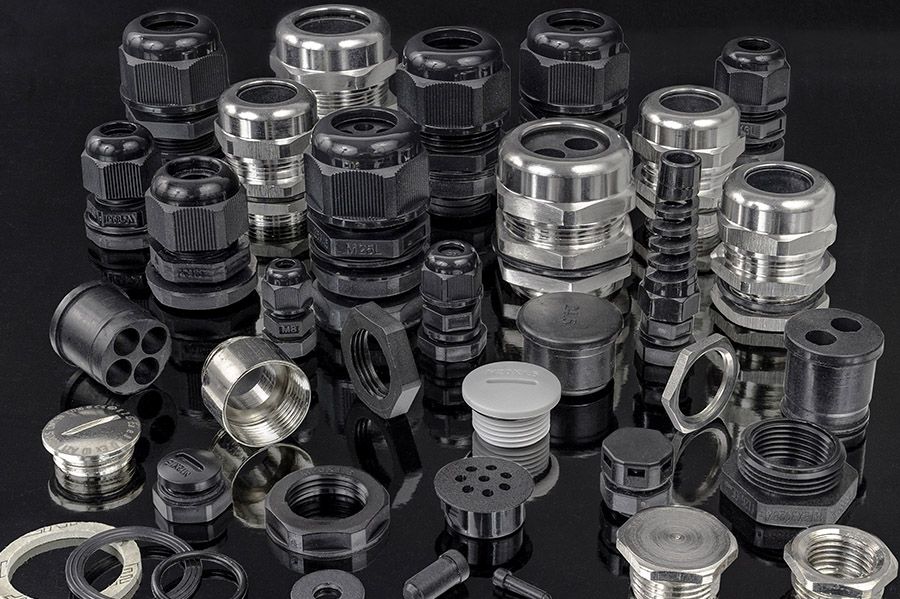
As a purchasing manager, you know that choosing the right components for your equipment is crucial for ensuring the safety and longevity of your products.
People rely on your product knowledge when it comes to purchasing the right products, at the right price, arriving at the right time.
The following guide covers the most commonly asked questions and topics in relation to cable glands.
What are cable glands?
Cable glands are a small but important part of any electrical or mechanical system, as they provide a secure and watertight seal around cables and wires.
Also known as cable connectors or cord grips, they’re mechanical devices that are used to attach and secure electrical cables and wires to equipment.
They’re designed to provide strain relief and to prevent the cables from being pulled or twisted out of their connections.
What is a cable gland used for?
Cable glands are primarily used to seal cables as they pass through bulkheads, panels, or enclosures, ensuring that the equipment remains watertight and protected from the elements.
They are also used to provide a secure connection for grounding wires and to prevent the cables from chafing against sharp edges.
What materials are cable glands made of?
Cable glands can be made from a variety of materials such as plastic, brass, stainless steel, aluminium, and nickel-plated brass, depending on the application and environment they’ll be used in.
Different types of cable glands
There are many different types of cable glands available on the market, each with its own unique features and benefits. Some common types include;
- Waterproof cable glands: These are designed to provide a watertight seal around cables, making them ideal for use in outdoor or wet environments.
- Nylon cable glands: These are made from durable and lightweight nylon material, which makes them ideal for use in applications where weight is a concern.
- Metal cable glands: These are made from brass, stainless steel, or aluminum and are designed to provide a strong and durable connection for heavy-duty applications.
- Screw-fix cable glands: These are designed to be attached to panels or enclosures using screws, making them easy to install and remove.
- 90-degree cable glands: These are designed to provide a right-angle connection for cables, which can be useful in tight spaces or applications where cable routing is restricted.
- Multi-wire cable glands: These are designed to accommodate multiple cables or wires, making them ideal for applications where space is limited.
- Cable gland blanking plug: These are used to seal off unused cable entries in panels or enclosures, providing an extra level of protection against dust and moisture.
What are wire glands?
Wire glands are another term for cable glands. They are used to secure and protect electrical cables as they pass through panels, bulkheads, or enclosures.
What is the difference between a standard and explosion-proof cable gland?
An explosion-proof cable gland is designed to prevent the ignition of flammable gases or dusts in hazardous environments.
They are constructed with additional safety features such as increased cable retention and sealing, as well as being made of materials that can withstand high temperatures and pressures.
Cable gland sizes
Cable glands come in a variety of sizes to accommodate different cable diameters. It's important to choose the correct size for your application to ensure a secure and watertight seal.
The right size of cable gland is chosen based on the outer diameter of the cable being used.
Common sizes range from M6 to M75, with some larger sizes available for heavy-duty applications.
Can cable glands be used with armoured cables?
Yes, cable glands can be used with armoured cables. There are specific types of cable glands designed to accommodate the unique features of armoured cables.
Are there any environmental considerations when selecting a cable gland?
Yes, environmental considerations should be taken into account when selecting a cable gland. Factors such as temperature, moisture, dust, and chemicals can impact the performance and longevity of a cable gland.
Can cable glands be reused?
Cable glands can be reused, but it is important to ensure that they are not damaged or worn out before reuse. It is recommended to inspect the cable gland thoroughly before reuse.
How do I ensure that my cable gland is IP rated?
To ensure that a cable gland is IP rated, it is important to check the manufacturer's specifications for the product. The IP rating indicates the level of protection against dust and moisture ingress.
What are the key safety considerations when using cable glands?
Some key safety considerations when using cable glands include selecting the appropriate type of cable gland for the environment, ensuring that the gland is installed correctly and securely, and complying with any industry standards or regulations.
Can cable glands be used in hazardous locations?
Yes, cable glands can be used in hazardous locations. However, it is important to select a cable gland that is suitable for the specific hazardous environment, such as explosion-proof cable glands for areas with flammable gases or dusts.
Are there any industry standards or regulations that I need to comply with when using cable glands?
In Australia, cable glands must comply with the relevant Australian standards, such as AS/NZS 3000:2018 Electrical installations (known as the Australian/New Zealand Wiring Rules).
What is the maximum operating temperature for cable glands?
The maximum operating temperature for cable glands can vary depending on the material and type of gland. It is important to check the manufacturer's specifications for the product to ensure that it is suitable for the operating temperature of the environment.
Are there any accessories available for cable glands, such as lock nuts or sealing rings?
Yes, there are various accessories available for cable glands such as lock nuts, sealing rings, and adaptors. These accessories can provide additional functionality and customization for the specific application.
Summary
Cable glands are an important component of any electrical or mechanical system, providing a secure and watertight seal around cables and wires.
They come in many different types and sizes to accommodate a wide range of applications, from lightweight nylon glands to heavy-duty metal glands.
By understanding the different types and sizes of cable glands available, you can choose the right components for your equipment and ensure its safety and longevity.
Don't forget to consider factors such as waterproofing, screw-fixing, 90-degree connections, multi-wire capabilities, and locking nuts when selecting your cable glands.
If you have any further questions regarding cable glands, please don’t hesitate to call our experts at NPA on (08) 8268 2733 or click here to view our range available for sale online.
See "Related blog posts" below to view other products in the NPA Buyer’s Guide Series

